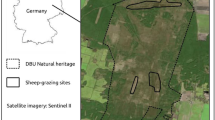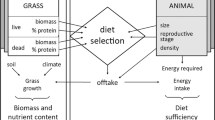Abstract
The discussion about the impact of pastoral systems on ecosystems has been profoundly shaped by Hardin’s “tragedy of the commons” argument that held pastoralists responsible for overgrazing the range. Recent studies have shown that grazing ecosystems are much more complex and dynamic than was previously assumed and that pastoralists adaptively manage these systems. However, we still have little understanding how everyday herding affects ecosystems at the landscape level. We conducted a study of daily herd movements and grazing strategies in a mobile pastoral system in the Logone floodplain, Cameroon. We integrated GPS/GIS technology, video recordings of animal behavior, and ethnographic methods to develop a more accurate measurement of grazing pressure that takes into account both livestock densities and grazing behavior. We used the resulting grazing pressure data to evaluate existing conceptual models of grazing pressure at a landscape level. We found that models that predict that grazing pressure is skewed towards the direction of water most accurately reflect the situation in the Logone floodplain in the dry season. However, we found that the higher grazing pressure is not only the result of a higher density of cattle but also a change in the grazing behavior of animals after watering. Finally, we caution that the models of grazing pressure in the dry season cannot simply be extrapolated to the landscape level because mobile pastoralists do not remain in one central place.








Similar content being viewed by others
References
Adriansen, H. K. (2005). Pastoral mobility: a review. Nomadic Peoples 9(1 & 2): 207–214.
Adriansen, H. K., and Nielsen, T. T. (2005). The geography of pastoral mobility: a spatio-temporal analysis of GPS data from Sahelian Senegal. GeoJournal 64: 177–188.
Ayantunde, A. A., Williams, T. O., Udo, H. M. J., Fernandez-Rivera, S., Hiernaux, P., and van Keulen, H. (2000). Herders' perceptions, practice, and problems of night grazing in the Sahel: case studies from Niger. Human Ecology 28(1): 109–130.
Bailey, D. W., Gross, J. E., Laca, E. A., Rittenhouse, L. R., Coughenour, M. B., Swift, D. M., et al. (1996). Mechanisms That Result in Large Herbivore Grazing Distribution Patterns. Journal of Range Management 49(5): 386–400.
Barbari, M., Conti, L., Koostra, B. K., Masi, G., Guerri, F. S., and Workman, S. R. (2006). The Use of Global Positioning and Geographical Information Systems in Management of Extensive Cattle Grazing. Biosystems Engineering 95(2): 271–280.
Bassett, T. J. (1986). Fulani herd movements. Geographical review 26(3): 234–248.
Behnke, R. H., Scoones, I., and Kerven, C. (eds.) (1993). Range ecology at disequilibrium: new models of natural variability and pastoral adaptation in African Savannas. Overseas Development Institute, London.
Bollig, M., and Schulte A. (1999). Environmental change and pastoral perceptions: degradation and indigenous knowledge in two African pastoral communuties. Human ecology 27(3): 493–515
Boutrais, J. (1999). Journées de bergers au Nord-Cameroun. In Poncet, Y., and Bernus, E. (eds.), Les temps du Sahel: en hommage à Edmond Bernus. IRD Institut de recherche pour le développement, Paris, pp. 55–80.
BurnSilver, S. B., Boone, R. B., and Galvin, K. A. (2003). Linking pastoralists to heterogenous landscape: the case of four Maasai ranches in Kahiado District, Kenya. In Fox, J., Rindfuss, R. R., Walsh, S. J., and Mishra, V. (eds.), People and the environment: approaches for linking household and community surveys to remote sensing and GIS. Kluwer, Boston (MA), pp. 173–199.
Butt, B. (2009). Seasonal space-time dynamics of cattle behavior and mobility among Maasai pastoralists in semi-arid Kenya. Journal of Arid Environments 74(3): 403–413 doi:10.1016/j.jaridenv.2009.09.025.
Butt, B. (2010). Pastoral resource access and utilization: quantifying the spatial and temporal relationships between livestock mobility, density and biomass availability in southern Kenya. Land degradation and development xxx(x): xx–xxx doi:10.1002/ldr.989.
Butt, B., Shortridge, A., and WinklerPrins, A. M. G. A. (2009). Pastoral Herd Management, Drought Coping Strategies, and Cattle Mobility in Southern Kenya. Annals of the Association of American Geographers 99(2): 309–334.
Coppolillo, P. B. (2000). The Landscape Ecology of Pastoral Herding: Spatial Analysis of Land Use and Livestock Production in East Africa. Human ecology 28(4): 527–560.
Coppolillo, P. B. (2001). Central-place analysis and modeling of landscape-scale resource use in East African agropastoral system. Landscape Ecology 16(3): 205–219.
De Boer, W. F., and Prins, H. H. T. (1989). Decisions of cattle herdsmen in Burkina Faso and optimal foraging models. Human Ecology 17: 445–464.
Dyson-Hudson, N., and Dyson-Hudson, R. (1980). Nomadic pastoralism. Annual Review of Anthropology 9: 15–61.
Ellis, J. E., and Swift, D. M. (1988). Stability of African pastoral ecosystems: alternative paradigms and implications for development. Journal of Range Management 41(6): 450–459.
Gautier, D., Bonnerat, A., and Njoya, A. (2005). The relationship between herders and trees in space and time in northern Cameroon. The geographical journal 171(4): 324–339.
Hardin, G. (1968). The tragedy of the commons. Science 162(3859): 1243–1248.
Homewood, K., and Rodgers, W. A. (1991). Maasailand ecology: pastoralist development and wildlife conservation in Ngorongoro, Tanzania. Cambridge University Press, Cambridge.
Krätli, S. (2008). Cattle Breeding, Complexity and Mobility in a Structurally Unpredictable Environment: The WoDaaBe Herders of Niger. Nomadic Peoples 12(1): 11–41.
Lamprey, H. F. (1983). Pastoralism yesterday and today: the overgrazing problem. In Bourliere, F. (ed.), Ecosystems of the world 13: tropical savannas. Elsevier, Amsterdam, pp. 643–666.
McCabe, J. T. (2004). Cattle Bring Us to Our Enemies: Turkana Ecology, Politics, and Raiding in a Disequilibrium System. Michigan University Press, Ann Arbor.
Moritz, M., Scholte, P., and Kari, S. (2002). The demise of the nomadic contract: arrangements and rangelands under pressure in the Far North of Cameroon. Nomadic Peoples 6(1): 127–146.
Niamir-Fuller, M. (ed.) (1999). Managing mobility in African rangelands: the legitimization of transhumance. Intermediate technology, London.
Oba, G., Stenseth, N. C., and Lusigi, W. J. (2000). New Perspectives on sustainable grazing management in arid zones of sub-saharan Africa. BioScience 50(1): 35–51.
Picardi, A. C., and Seifert, W. W. (1976). A Tragedy of the Commons in the Sahel. Technology Review 78(6): 42–51.
Schareika, N. (2003). Know to move, move to know: ecological knowledge and herd movement strategies among the Wodaabe of Southeastern Niger. FAO Inter-Departmental Working Group on Biological Diversity for Food and Agriculture, Rome.
Schlecht, E., Hulsebusch, C., Mahler, F., and Becker, K. (2004). The use of differentially corrected global positioning system to monitor activities of cattle at pasture. Applied Animal Behaviour Science 85(3–4): 185–202.
Scholte, P. (2007). Maximum flood depth characterises above-ground biomass in African shallowly flooded grasslands. Journal of Tropical Ecology 23: 63–72.
Scholte, P., and Brouwer, J. (2008). The Relevance of Key Resource Areas for Large-scale Movements of Livestock: developing the KRA-concept based on examples from Sahelian floodplains. In Prins, H. H. T., and van Langevelde, F. (eds.), Resource Ecology: spatial and temporal aspects of foraging. Springer, Wageningen, pp. 211–232.
Scholte, P., Kari, S., and Moritz, M. (1996). The involvement of nomadic and transhumance pastoralists in the rehabilitation and management of the Logone flood plain, North Cameroon. IIED Drylands Programme Issues Paper 66: 1–21.
Scholte, P., Kari, S., Moritz, M., and Prins, H. (2006). Pastoralist Responses to Floodplain Rehabilitation in Northern Cameroon. Human ecology 34(1): 27–51.
Sinclair, A. R. E., and Fryxell, J. M. (1985). The Sahel of Africa: ecology of a disaster. Canadian Journal of Zoology 63: 987–994.
Sonneveld, B. G. J. S., Keyzer, M. A., Georgis, K., Pande, S., Ali, A. S., and Takele, A. (2009). Following the Afar: Using remote tracking systems to analyze pastoralists' trekking routes. Journal of Arid Environments 73(11): 1046–1050.
Spencer, P. (1973). Nomads in alliance: symbiosis and growth among the Rendille and Samburu of Kenya. Oxford University Press, London.
Stenning, D. J. (1957). Transhumance, migratory drift, migration; patterns of pastoral Fulani nomadism. Journal of the Royal Anthropological Institute 87: 57–73.
Sullivan, S., and Rohde, R. (2002). On non-equilibrium in arid and semi-arid grazing systems. Journal of Biogeography 29(12): 1595–1618.
Turner, M. D., and Hiernaux, P. (2002). The use of herders' accounts to map livestock activities across agropastoral landscapes in Semi-Arid Africa. Landscape Ecology 17(5): 367–385.
Western, D. (1975). Water availability and its influence on the structure and dynamics of a savannah mammal community. East African Wildlife Journal 13: 265–286.
Westra, T., and De Wulf, R. R. (2007). Monitoring Sahelian floodplains using Fourier analysis of MODIS time-series data and artificial neural networks. International Journal of Remote Sensing 28(7): 1595–1610.
Acknowledgements
This research has been supported by the National Science Foundation (BCS-0748594), the National Geographic Society (8306-07), and the College of Social and Behavioral Sciences and the Anthropology Department at the Ohio State University. We want to thank Mouazamou Ahmadou for video recording, and the Ministry of Scientific Research and Innovation (MINRESI) and the Ecole de Faune de Garoua for granting research permission and research affiliation (2008–2010), Bilal Butt, Matthew Turner, and two anonymous reviewers for comments on an earlier version of this paper, and all the pastoralists for helping us with our research. All maps are made by Eric Soma.
Author information
Authors and Affiliations
Corresponding author
Rights and permissions
About this article
Cite this article
Moritz, M., Soma, E., Scholte, P. et al. An Integrated Approach to Modeling Grazing Pressure in Pastoral Systems: The Case of the Logone Floodplain (Cameroon). Hum Ecol 38, 775–789 (2010). https://doi.org/10.1007/s10745-010-9361-z
Published:
Issue Date:
DOI: https://doi.org/10.1007/s10745-010-9361-z




